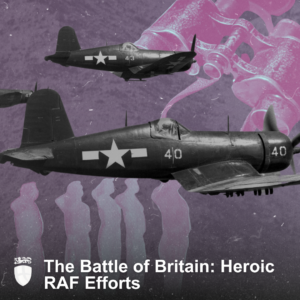
Experience the valour and history behind the Battle of Britain with our extensive collection of military sovereigns. Discover the key moments, the brave individuals involved, and the significant impact of this historical event. Dive into the details and explore how Hattons of London honours this legacy through our exclusive gold sovereign collections.
Table of Contents
- Table of Contents
- Introduction to the Battle of Britain
- Glossary of Terms
- What was the Battle About and Who Was Involved
- Air and Sea Blockade by Luftwaffe
- Destruction of Spitfire Factories
- Germany Attempts at Peace Negotiation
- Battle of France
- Operation Sea Lion
- France and England Declare War
- Conclusion and Outcome of the Battle
- Long Term Effects
- Supporting Our Veterans
The Battle of Britain was a pivotal moment in World War II, marking the first major military campaign fought entirely by air forces. Taking place between July and October 1940, it saw the Royal Air Force (RAF), Fleet Air Arm (FAA), and the Royal Navy defending the United Kingdom against large-scale attacks from Nazi Germany’s Luftwaffe. This battle not only demonstrated the resilience and determination of the British people but also significantly altered the course of the war.
Explore our range of military sovereigns to commemorate this historical event.
Glossary of Terms
- Luftwaffe: The aerial warfare branch of the German Wehrmacht during World War II.
- Spitfire: A British fighter aircraft used by the RAF and other Allied countries before, during, and after World War II.
- Reichstag: The German Parliament during the period of Nazi control.
What was the Battle About and Who Was Involved
The Battle of Britain was primarily about maintaining air superiority over the United Kingdom. Nazi Germany aimed to compel Britain to agree to a negotiated peace settlement. The RAF, FAA, and Royal Navy were central to the defence, facing relentless attacks from the Luftwaffe. British Prime Minister Winston Churchill and German leader Adolf Hitler were the central figures driving their respective nations’ strategies.
Air and Sea Blockade by Luftwaffe
The Luftwaffe aimed to cripple Britain through extensive bombing campaigns targeting airfields, radar stations, and ports. This strategy sought to disrupt British defences and pave the way for a potential invasion. Beginning in July 1940, the Luftwaffe mainly targeted coastal shipping convoys, as well as ports and shipping centres.
Destruction of Spitfire Factories
One of the Luftwaffe’s key objectives was to destroy British aircraft production capabilities, specifically targeting Spitfire factories. The Spitfire, known for its agility and speed, was a crucial element in the RAF’s defensive strategy. Despite losing more than 100 colleagues in the Luftwaffe air raids that flattened the Spitfire factory in Southampton, workers quickly relocated to alternative sites, including furniture stores, garages, and even a bus depot, to continue production.
Explore our Spitfire gold sovereign range and own a piece of history.
Germany’s Attempts at Peace Negotiation
Before the full-scale conflict began, Germany made several attempts to negotiate peace with Britain, hoping to avoid a prolonged and costly war. One notable attempt was Hitler’s 6 October 1939 Reichstag speech, where he condemned war and offered an olive branch of peace to France and Britain, stating that war results in ruins and endless graveyards.
Battle of France
The Battle of France, which preceded the Battle of Britain, saw the rapid defeat of French forces by German troops. Due to the ongoing Battle of France, Britain was left to face the threat of invasion by sea alone, underscoring the urgency of preparing for a potential invasion.
Operation Sea Lion
Operation Sea Lion was the codename for Nazi Germany’s planned invasion of the United Kingdom. The operation hinged on achieving air and naval superiority over the English Channel and the proposed landing sites. However, the German forces achieved neither at any point of the war, leading to the postponement and eventual cancellation of the operation.
France and England Declare War
Both France and the UK declared war on Germany on 3 September 1939, following Germany’s invasion of Poland. Hitler’s “Directive No. 6,” issued on 9 October 1939, planned the offensive to defeat these allies and gain territory in the Netherlands, Belgium, and northern France to serve as a base for the successful prosecution of the air and sea war against England.
Conclusion and Outcome of the Battle
The Battle of Britain concluded with a decisive victory for the RAF, preventing Germany from achieving air superiority and forcing Hitler to postpone and eventually cancel Operation Sea Lion. This victory marked a turning point in World War II, bolstering Allied morale and demonstrating the effectiveness of air power in modern warfare.
Long-Term Effects
The long-term effects of the Battle of Britain were profound, reshaping military strategies and contributing to the eventual defeat of Nazi Germany. It also reinforced the importance of technological innovation and international cooperation in securing peace.
Supporting Our Veterans
At Hattons of London, we honour the legacy of those who served through our commitment to supporting veterans. Learn more about how we help support our veterans.







